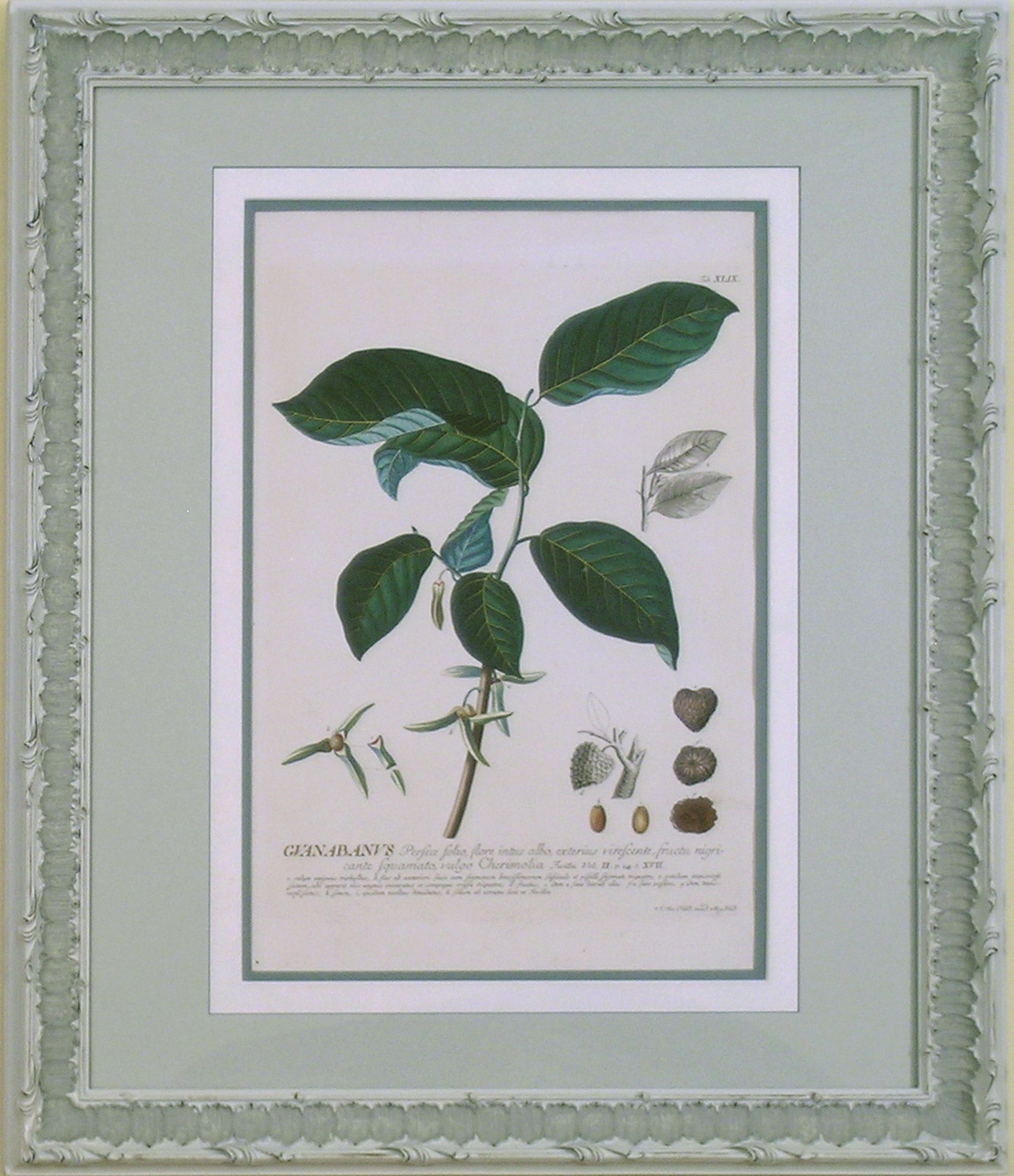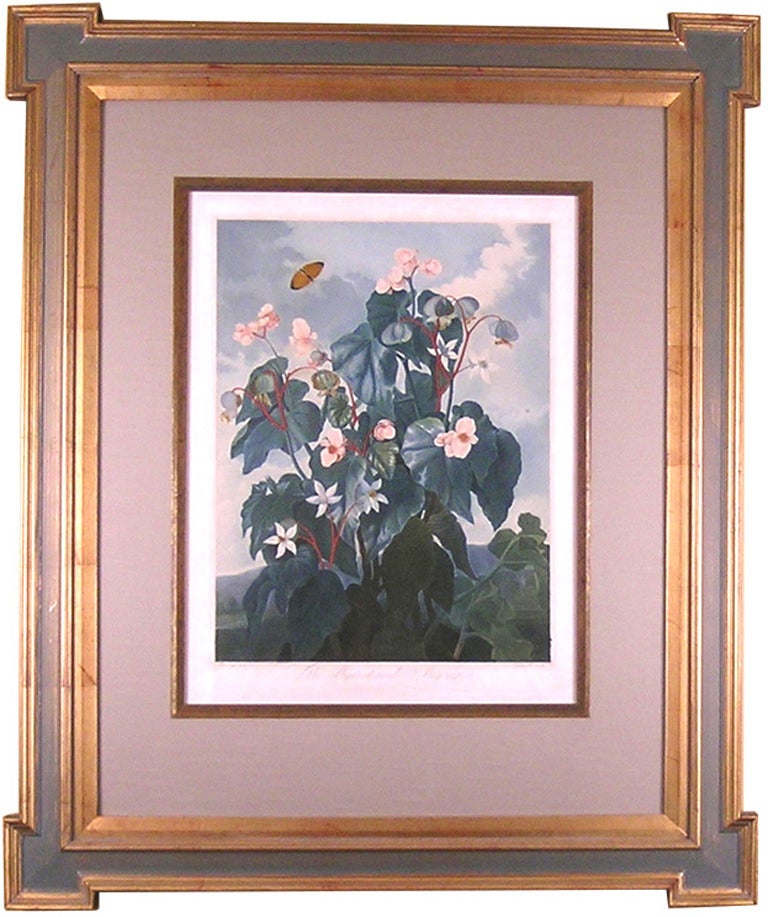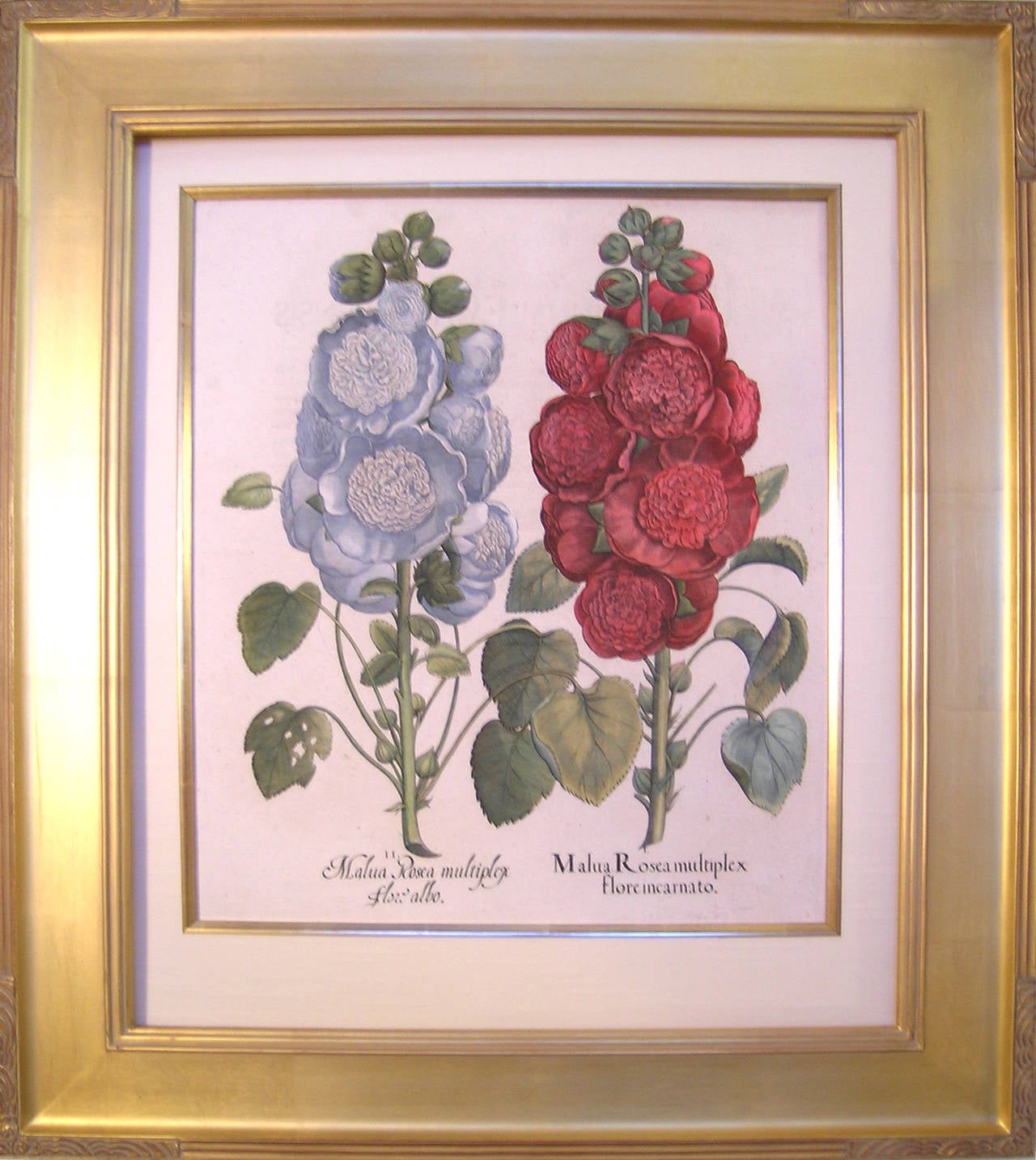Items Similar to Caryophyllus Major (Carnations)
Want more images or videos?
Request additional images or videos from the seller
1 of 7
Basilius BeslerCaryophyllus Major (Carnations)1613
1613
About the Item
This image would pair well with Besler's "Caryophyssus Flore" which is also listed.
BASIL BESLER (1561 – 1629).
Hortus Eystettensis.
Konrad Bauer. Altdorf, 1613, 1640, 1713 – 50.
Copper plate engravings with modern hand-color
374 plates. 21 ¼” to 21 ½” x 16” to 18”.
Hortus Eystettensis is without doubt one of the greatest flower books ever produced in any country. The first great florilegium, it is a landmark work in size and scope documenting pre-Linnaean botanical classification. The splendid stylization and aesthetics make it one of the most powerful botanical works ever produced.
Basil Besler, an apothecary of Nuremberg and botanist who managed the garden of Bishop Johann Conrad in Eichstatt, Germany, used it as an encyclopedic resource as the basis for Hortus Eystettensis, observing and depicting over a thousand flowers, representing 667 species. The Bishop's remarkable garden was one of the most extensive in Europe, containing a huge variety of European shrubs and flowering plants, as well as exotic specimens from Asia and the Americas. He endeavored to collect the new and exotic specimens arriving from far away lands. With the Bishop's patronage, Besler worked both as artist and publisher, directing a team of ten artists and engravers in creating 374 plates over a period of 16 years. Horticultural rather than botanical, it is the earliest pictorial record of flowers in a single garden. Summer, Fall, Winter, and Spring each have their own sections. An unparalleled achievement!
As the first large folio botanical, the plates depict over 1000 flowers, many of them exotics appearing for the first time. It would be decades before living examples of certain species were to be seen again. The Bishops’ Eden fell into disrepair after his death and with the outbreak of the Thrity Years War suffered complete neglect. By 1633 the magnificent gardens had ceased to exist. But they would not be forgotten. Besler’s original drawings (most of which are housed in the University Library, Erlangen) took sixteen years to complete. Besler supervised a team of painters and engravers including Domenicus & Raphael Custos, Wolfgang Kilian (stepson of Domenicus), Levin & Friedrich von Huisen, Peter Ilelburch, Johann Leopold, Servaes Raeven, Heinrich Ulrich Heronimus Lederer, et al. This unparalleled group worked between 1608 and 1612 when the last plates went to the printer. The Bishop died on the 2nd of November 1612. Up to that time Besler had received 7500 gold coins in payment. Printed in 1613, only three hundred copies were issued. However, the extensive information and generous depictions would be republished for over a century. For many years it was believed the copper plates on which they were engraved survived until 1817, when they were melted down by the Royal Mint in Munich. However, in 1998, during a reorganization of storage in Vienna’s Albertina Graphic Collection, 329 of the original plates were found. The whereabouts of the remainder remains a mystery.
One hundred and fifty years before Linnaeus created his thorough system of classification, Besler's great florilegium represented an impressive early attempt to classify plants for the benefit of botanists, doctors and apothecaries. Each plant is given a distinct and often descriptive Latin title, and related species are grouped together on the same plate, or over a series of plates. Almost all specimens are shown complete and accurately colored including delineations of their root systems. There were under one dozen copies colored at the time of publication probably for royal or wealthy patrons. Several happily survive in museums and libraries. Today we use them as a basis for coloring.
While Besler's work is obviously motivated by a scientific impulse to document and describe a remarkable collection of species, the beautiful presentation and dramatic stylization of the illustrations also convey a sense of the visual grandeur of the Bishop's great garden. By 1633 the famous garden had become a vegetable plot. Ultimately, this renowned botanical achievement would be plowed under and lost for all time. All the more reason to revere Besler's dramatic endeavor. Each specimen is placed on the page with an artist's understanding of formal and spatial relations. Most notable, the stylized depiction of foliage and root systems betrays a lively baroque sensibility, as the plants seem to dance across the page. The Besler "Florilegium" will hold forever in time a magnificent era of horticulture.
Reference: Hortus Eystettensis: The Bishop’s Garden & Besler’s Magnificent Book. Abrams. NY, 1994.
The Besler Florilegium: Plants of the Four Seasons. Abrams. NY, 1987.
- Creator:Basilius Besler (1561 - 1629, German)
- Creation Year:1613
- Dimensions:Height: 33.5 in (85.09 cm)Width: 29.5 in (74.93 cm)Depth: 1.25 in (3.18 cm)
- Medium:
- Movement & Style:
- Period:
- Condition:Clean, crisp image. Full margins. Beautiful hand-coloring. Matting has hand-drawn French lines with wash of color, gold papers, hand-colored bevel.
- Gallery Location:Florham Park, NJ
- Reference Number:
About the Seller
5.0
Gold Seller
These expertly vetted sellers are highly rated and consistently exceed customer expectations.
1stDibs seller since 2014
161 sales on 1stDibs
Typical response time: 3 hours
- ShippingRetrieving quote...Ships From: Florham Park, NJ
- Return PolicyA return for this item may be initiated within 1 day of delivery.
More From This SellerView All
- Meriana (Bugle Lily)By Georg Dionysius EhretLocated in Florham Park, NJGEORGE DIONSYSIUS EHRET (1708-1770). Plantae Selectae.... Text by Dr. Christoph Trew. Drawn by Georg Dionsysius Ehret. Engraved by Johannes Jacobus and Johannes Elias Haid. Nuremberg, 1750-73. Hand-colored engravings. Titles highlighted with goldleaf. 100 plates. 19.5” x 13.5” Unframed. A supplement of 20 plates issued by B.C. Vogel in 1790. "The dominant influence in botanical art during the middle years of the 18th century." "One of the finest records of cultivated flowers..." "His accuracy and general excellence as a true botanical artist have never been equaled." Ehret’s praises have been sung throughout the centuries. While his training was in gardening, Ehret's true talents were in his art. Drawing the specimens from life in the garden's in which he labored won Ehret his employer's praise and his co-workers jealousy. Not only were his botanical portraits highly accurate in every technical detail, they reflected an awe-inspiring love of subject. A restless man, Ehret wandered from Heidelberg through Germany to Vienna and Basle, working his way to Paris and finally settling in London. He was honored by peers and patrons wherever he traveled. Ehret's list of benefactors include the most brilliant and generous members of society in his day. However, it was Christoph Trew, a wealthy physician, lifelong supporter and friend, who published the work for which Ehret is best known, Plantae Selectae. Ehret went to Leiden to meet Carolus Linnaeus and they became the best of friends. It is the Linnaen classification of plants to which Ehret subscribed. In distinguishing of the sexual systems of plants and the cross-sectioning of specimens, based on the teachings of Linnaeus, Ehret's illustrations have become the standard followed by horticulturists throughout the centuries. Ehret is the only foreigner to be elected a Fellow of the Royal Society in England. The illustrations for Plantae Selectae were printed in black and white and painstaking colored by hand at the time of publication. The color is superb! All of the initial words of the titles were gilded; a glorious tribute to an achievement of excellence. Various scholars at the time of publication praised the book highly, singling out the excellent quality of Ehret's watercolor studies, as well as Haid's fidelity to them. In a letter to Linnaeus in the 1750's, Dr. Trew called the book "one of the miracles of our century in the natural sciences." In the 1960's, Claus Nissen wrote "the Plantae Selectae became the most beautiful German plant...Category
1750s Academic Prints and Multiples
MaterialsGold Leaf
- Guanabanus (Guabana or Soursop Fruit)By Georg Dionysius EhretLocated in Florham Park, NJGEORGE DIONSYSIUS EHRET (1708-1770). Plantae Selectae.... Text by Dr. Christoph Trew. Drawn by Georg Dionsysius Ehret. Engraved by Johannes Jacobus and Johannes Elias Haid. Nuremberg, 1750-73. Hand-colored engravings. Titles highlighted with goldleaf. 100 plates. 19.5” x 13.5” Unframed. A supplement of 20 plates issued by B.C. Vogel in 1790. "The dominant influence in botanical art during the middle years of the 18th century." "One of the finest records of cultivated flowers..." "His accuracy and general excellence as a true botanical artist have never been equaled." Ehret’s praises have been sung throughout the centuries. While his training was in gardening, Ehret's true talents were in his art. Drawing the specimens from life in the garden's in which he labored won Ehret his employer's praise and his co-workers jealousy. Not only were his botanical portraits highly accurate in every technical detail, they reflected an awe-inspiring love of subject. A restless man, Ehret wandered from Heidelberg through Germany to Vienna and Basle, working his way to Paris and finally settling in London. He was honored by peers and patrons wherever he traveled. Ehret's list of benefactors include the most brilliant and generous members of society in his day. However, it was Christoph Trew, a wealthy physician, lifelong supporter and friend, who published the work for which Ehret is best known, Plantae Selectae. Ehret went to Leiden to meet Carolus Linnaeus and they became the best of friends. It is the Linnaen classification of plants to which Ehret subscribed. In distinguishing of the sexual systems of plants and the cross-sectioning of specimens, based on the teachings of Linnaeus, Ehret's illustrations have become the standard followed by horticulturists throughout the centuries. Ehret is the only foreigner to be elected a Fellow of the Royal Society in England. The illustrations for Plantae Selectae were printed in black and white and painstaking colored by hand at the time of publication. The color is superb! All of the initial words of the titles were gilded; a glorious tribute to an achievement of excellence. Various scholars at the time of publication praised the book highly, singling out the excellent quality of Ehret's watercolor studies, as well as Haid's fidelity to them. In a letter to Linnaeus in the 1750's, Dr. Trew called the book "one of the miracles of our century in the natural sciences." In the 1960's, Claus Nissen wrote "the Plantae Selectae became the most beautiful German plant...Category
1750s Academic Prints and Multiples
MaterialsGold Leaf
- Urtica (Nettle)By Georg Dionysius EhretLocated in Florham Park, NJGEORGE DIONSYSIUS EHRET (1708-1770). Plantae Selectae.... Text by Dr. Christoph Trew. Drawn by Georg Dionsysius Ehret. Engraved by Johannes Jacobus and Johannes Elias Haid. Nuremberg...Category
1750s Academic Prints and Multiples
MaterialsGold Leaf
- Heliocarpus (Tree, Malvales)By Georg Dionysius EhretLocated in Florham Park, NJGEORGE DIONSYSIUS EHRET (1708-1770). Plantae Selectae.... Text by Dr. Christoph Trew. Drawn by Georg Dionsysius Ehret. Engraved by Johannes Jacobus and Johannes Elias Haid. Nuremberg, 1750-73. Hand-colored engravings. Titles highlighted with goldleaf. 100 plates. 19.5” x 13.5” Unframed. A supplement of 20 plates issued by B.C. Vogel in 1790. "The dominant influence in botanical art during the middle years of the 18th century." "One of the finest records of cultivated flowers..." "His accuracy and general excellence as a true botanical artist have never been equaled." Ehret’s praises have been sung throughout the centuries. While his training was in gardening, Ehret's true talents were in his art. Drawing the specimens from life in the garden's in which he labored won Ehret his employer's praise and his co-workers jealousy. Not only were his botanical portraits highly accurate in every technical detail, they reflected an awe-inspiring love of subject. A restless man, Ehret wandered from Heidelberg through Germany to Vienna and Basle, working his way to Paris and finally settling in London. He was honored by peers and patrons wherever he traveled. Ehret's list of benefactors include the most brilliant and generous members of society in his day. However, it was Christoph Trew, a wealthy physician, lifelong supporter and friend, who published the work for which Ehret is best known, Plantae Selectae. Ehret went to Leiden to meet Carolus Linnaeus and they became the best of friends. It is the Linnaen classification of plants to which Ehret subscribed. In distinguishing of the sexual systems of plants and the cross-sectioning of specimens, based on the teachings of Linnaeus, Ehret's illustrations have become the standard followed by horticulturists throughout the centuries. Ehret is the only foreigner to be elected a Fellow of the Royal Society in England. The illustrations for Plantae Selectae were printed in black and white and painstaking colored by hand at the time of publication. The color is superb! All of the initial words of the titles were gilded; a glorious tribute to an achievement of excellence. Various scholars at the time of publication praised the book highly, singling out the excellent quality of Ehret's watercolor studies, as well as Haid's fidelity to them. In a letter to Linnaeus in the 1750's, Dr. Trew called the book "one of the miracles of our century in the natural sciences." In the 1960's, Claus Nissen wrote "the Plantae Selectae became the most beautiful German plant...Category
1750s Academic Prints and Multiples
MaterialsGold Leaf
- Oblique-leaved BegoniaBy Dr. Robert John ThorntonLocated in Florham Park, NJThis piece would pair well with Thornton's "Hyacinths" which is also listed. DR. ROBERT JOHN THORNTON (c1765 – 1832). The Temple of Flora. London, 17...Category
Early 19th Century Academic Prints and Multiples
MaterialsHandmade Paper, Laid Paper, Plexiglass, Rag Paper, Silk, Watercolor, Arc...
- Malva Rosea (Hollyhock, Mallow)By Basilius BeslerLocated in Florham Park, NJThis piece would pair well with Basil Besler's "Malva hortensis flore..." which is also listed BASIL BESLER (1561 – 1629). Hortus Eystettensis. Konrad ...Category
18th Century and Earlier Academic Prints and Multiples
MaterialsRag Paper, Silk, Watercolor, Archival Paper, Archival Tape, Gesso, Handm...
You May Also Like
- Color-Blast BouquetBy Dionisios FragiasLocated in New York, NYDionisios Fragias is a New York -based artist born on the Greek island of Kefalonia and raised in New York City. He is the protege of the artist Jeff Koons whose years-long mentorshi...Category
2010s Abstract Abstract Prints
MaterialsArchival Tape, Archival Ink, Archival Paper, Color, Archival Pigment
- “Innocent Captivation Amusement Pastorale”By Anthony CardonLocated in Southampton, NYOriginal stipple engraving on a verge type of hand laid paper. The overall size of the engraving is 15.75 inches by 12.75 inches The image size of the engraving is 14 inches by 12 i...Category
Early 1800s Academic Figurative Prints
MaterialsEngraving, Laid Paper
- “Returning Home”By Hermanus Jan Hendrik RijkelijkhuysenLocated in Southampton, NYOriginal etching on Ingres laid paper (watermarked, see last photograph) attributed to the hand of the well known Dutch artist, Hermanus Jan Hendrik Rijkelijkhuysen. No visible signature. Sheet size 9.25 by 12 inches. Sight size 7 by 9 inches. Under glass. Circa 1875. Condition is excellent. Professionally matted and framed in a walnut colored frame with gold leaf edge. Overall framed measurements are 12.75 by 14.5 inches. Gallery label verso. Provenance: A Sarasota, Florida collector. Biography: Hermanus Jan Hendrik Rijkelijkhuysen (1813-1883) was a landscape painter and etcher. Rijkelijkhuysen spent most of his life working in the vicinity of his birthplace Utrecht. Inspired by the polders on the one hand and the Utrechtse Heuvelrug on the other, he mainly painted and etched water...Category
1870s Academic Landscape Prints
MaterialsLaid Paper, Etching
- “Les Revers de la Fortune”Located in Southampton, NYOriginal stipple engraving with colors titled “Les Revers de la Fortune” (Reversal of Fortune) by the well known French engraver, Louis Marin Bonnet...Category
1780s Academic Interior Prints
MaterialsLaid Paper, Engraving
- "The Temptation of Saint Anthony " Etching, SignedBy Fernand CormonLocated in Milwaukee, WI"The Temptation of Saint Anthony" is an original etching by Fernand Cormon. This piece has the artist's stamp. The piece is signed in pencil by the artis...Category
1890s Academic Figurative Prints
MaterialsEtching, Paper, Ink, Laid Paper
- Eagle /// Antique Ornithology Bird Saverio Manetti Italian Watercolor EngravingBy Saverio ManettiLocated in Saint Augustine, FLArtist: Saverio Manetti (Italian, 1723-1785) Title: "Eagle" (Plate V - 5) Portfolio: Storia Naturale Degli Uccelli (The Natural History of Birds) Year: 1767-1776 Medium: Original Hand-Colored Engraving on watermarked laid paper Limited edition: Unknown Printer: Unknown Publisher: heirs of Francesco Mouck (Vols. I-III), Gaetano Cambiagi (Vol. IV), Giuseppe Vanni (Vol. V), Florence, Italy Sheet size: 16.75" x 14.5" Platemark size: 13.63" x 10.88" Condition: Some minor surface marks mainly in margins. In excellent condition with strong colors Rare Notes: Provenance: private collection - Haarlem, Netherlands. Engraved and hand-colored by Italian artists Lorenzo Lorenzi (Active: 1750-1780) and Violante Vanni (1732-1776). Latin and Italian texts by Saverio Manetti. Comes from Manetti's monumental 5 book volume "Storia Naturale Degli Uccelli (The Natural History of Birds)", (1767-1776), which consists of 600 hand-colored prints, miniature and life-size prints, made from engraved plates. Unidentified watermark in very center of sheet. Comes with its accompanying information sheet. Eagle is the common name for many large birds of prey of the family Accipitridae. Eagles belong to several groups of genera, some of which are closely related. Most of the 60 species of eagle are from Eurasia and Africa. Manetti's extraordinary "Storia Naturale Degli Uccelli (The Natural History of Birds)", 1767-1776 was commissioned by Maria Luisa, the Grand Duchess of Tuscany. It is a massive 5 book volume set...Category
1770s Old Masters Animal Prints
MaterialsIntaglio, Laid Paper, Handmade Paper, Watercolor, Engraving
Recently Viewed
View AllMore Ways To Browse
The Bishop
Sense And Sensibility
Antique Tape
Four Flower Prints
Modern Botanical Prints
Botanical Prints Modern
Antique Paper Documents
Vegetable Print
1000 Flowers
Vienna 18th
Botanical Print Plates
Pair 18th Century Prints
Antique Carnations
Antique Carnation
European Botanical Art Prints
Antique Plates Ny
Collectible Antique Coins
Asian Coin Art





